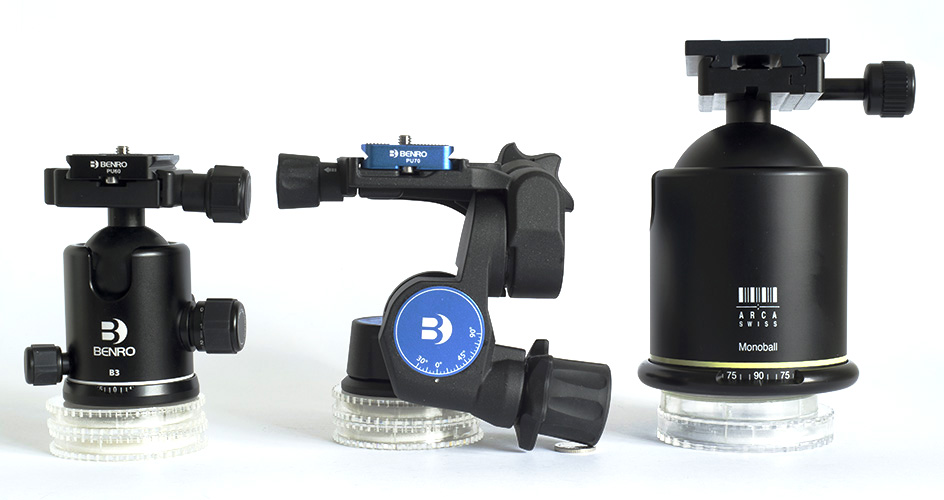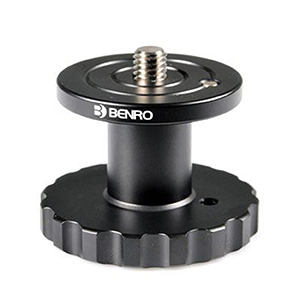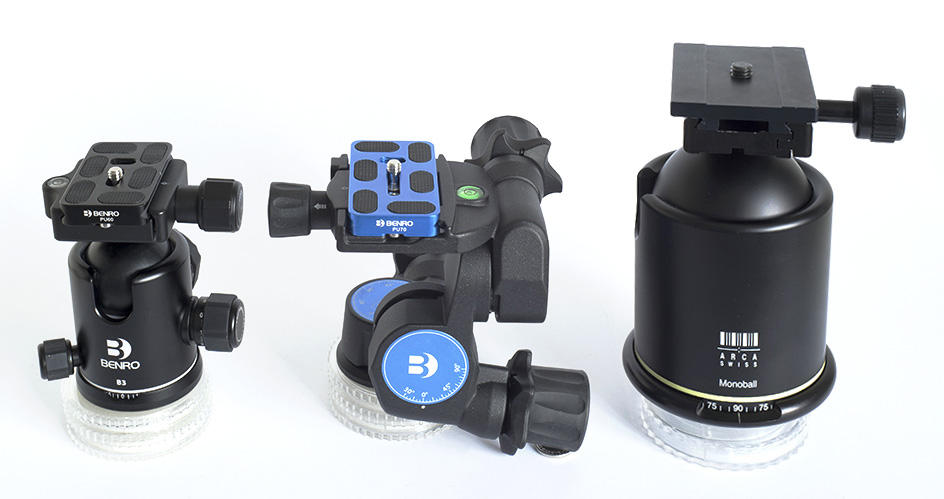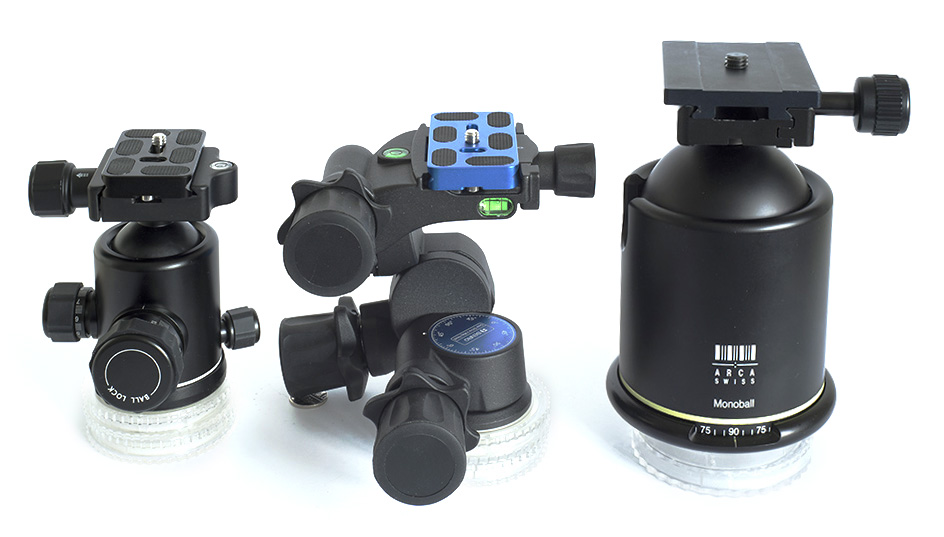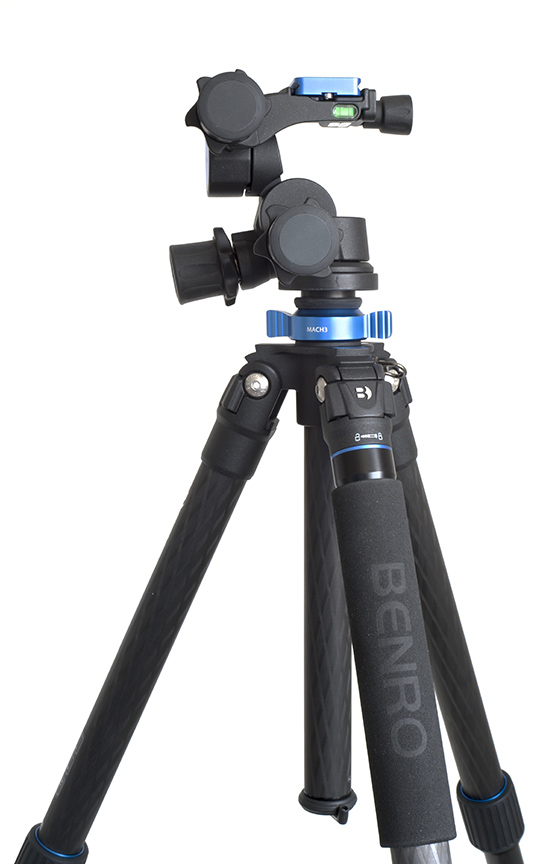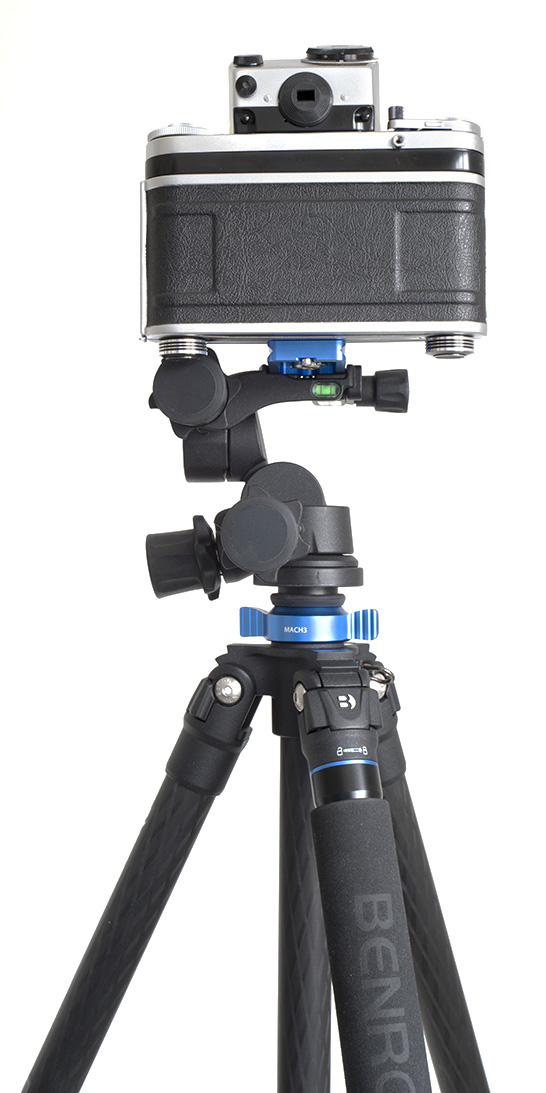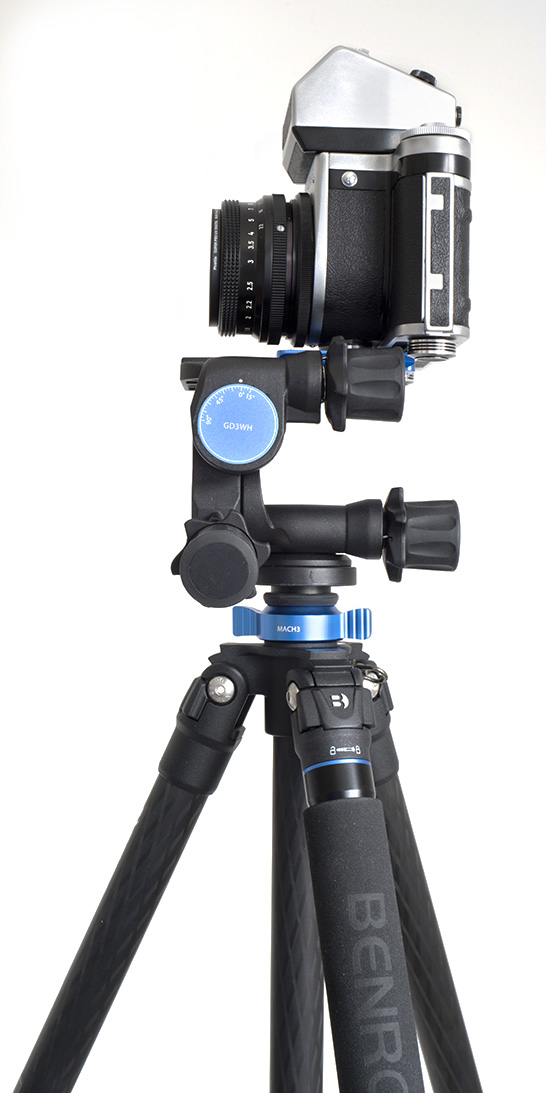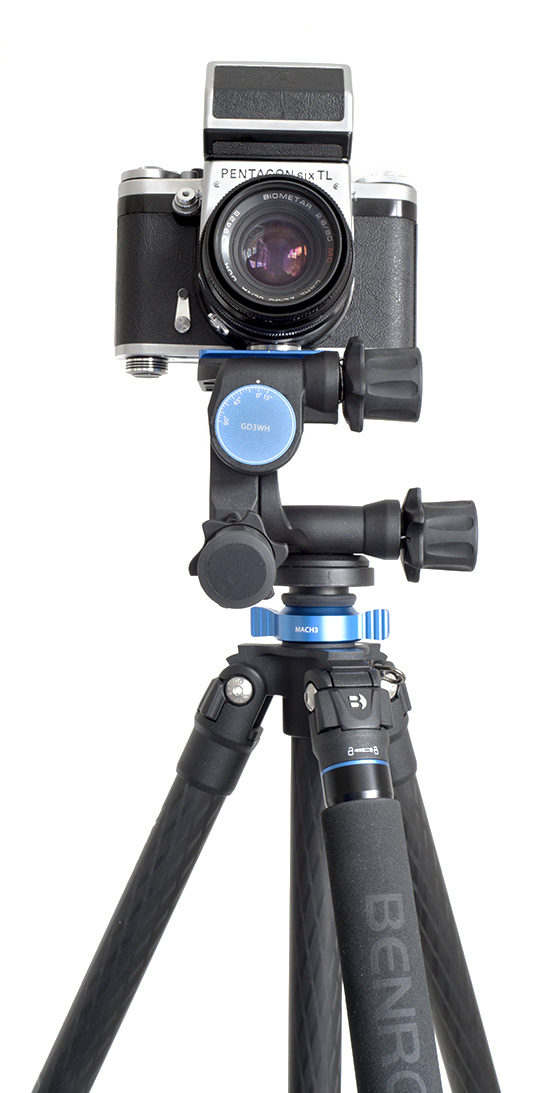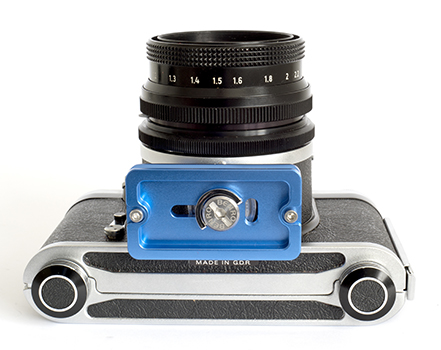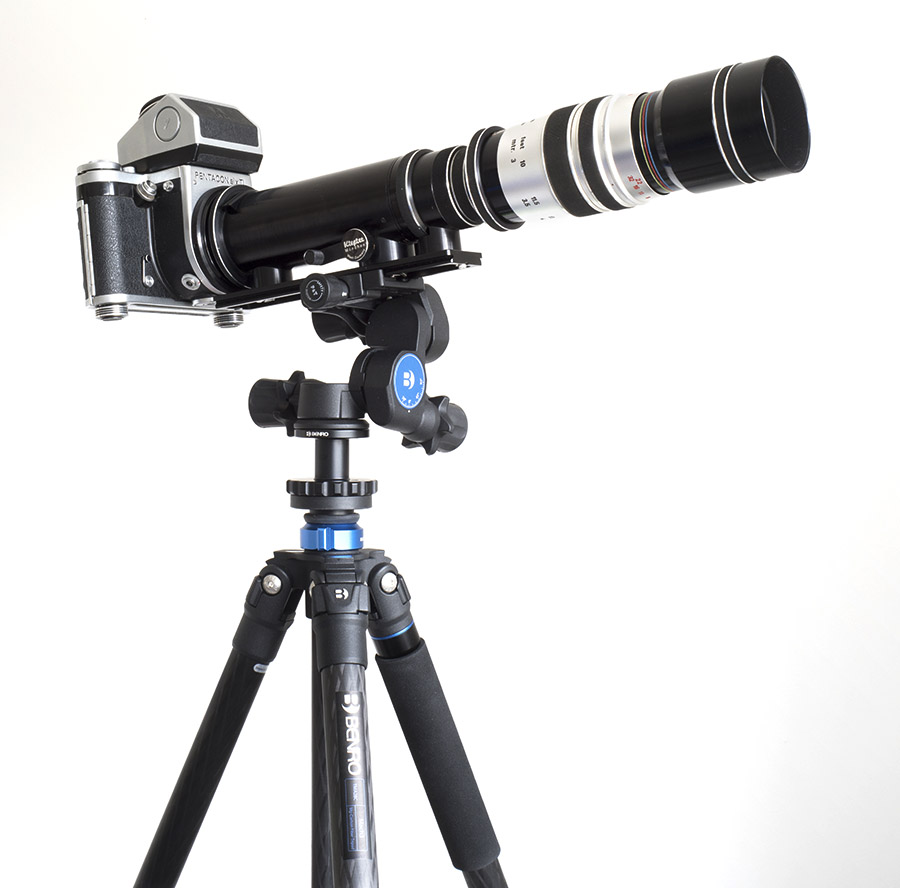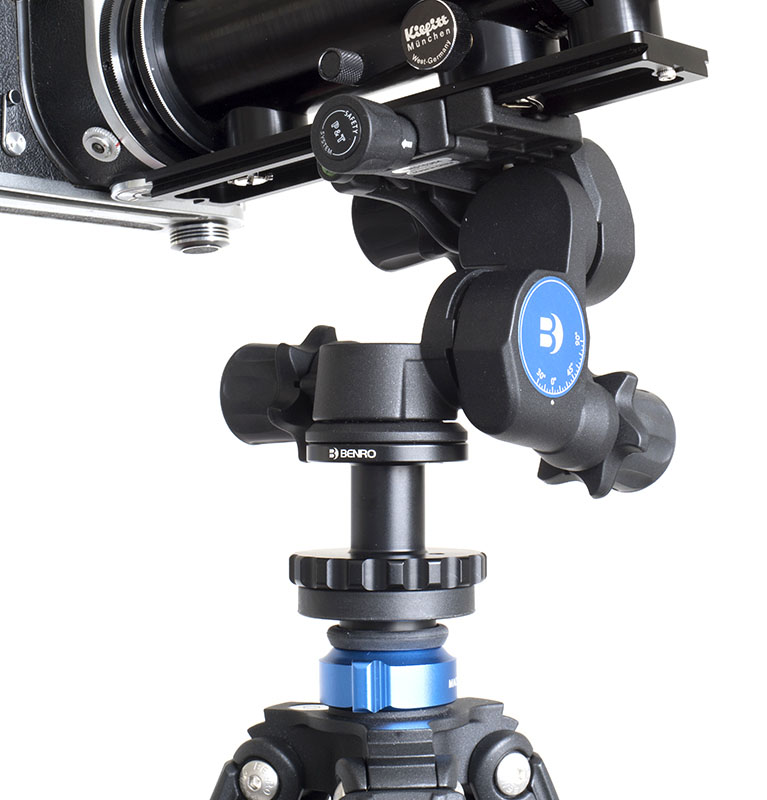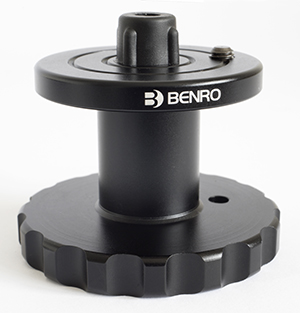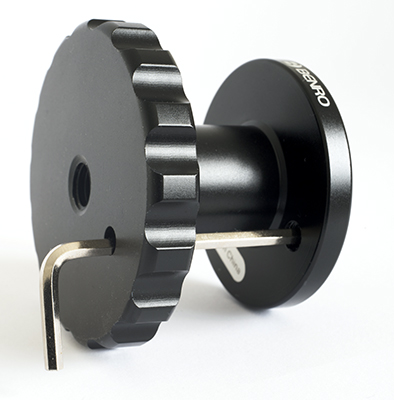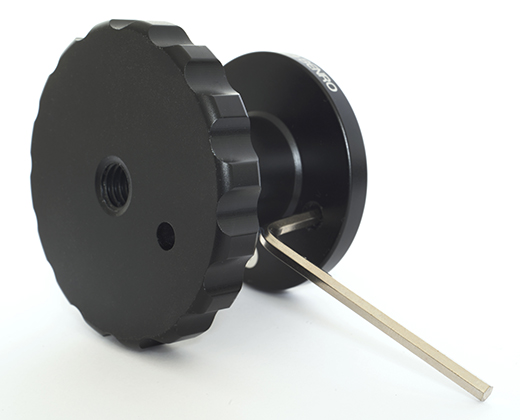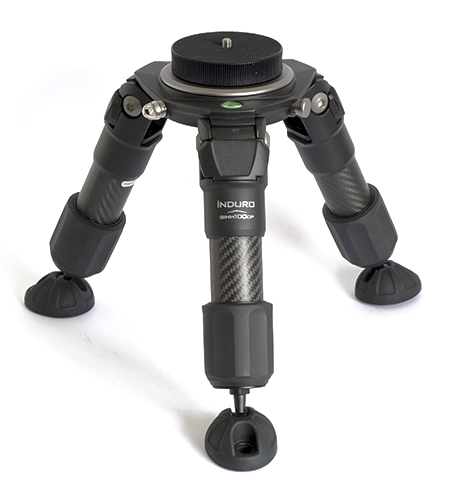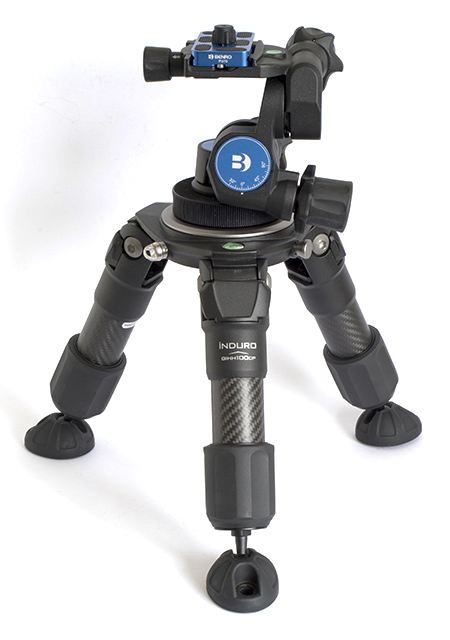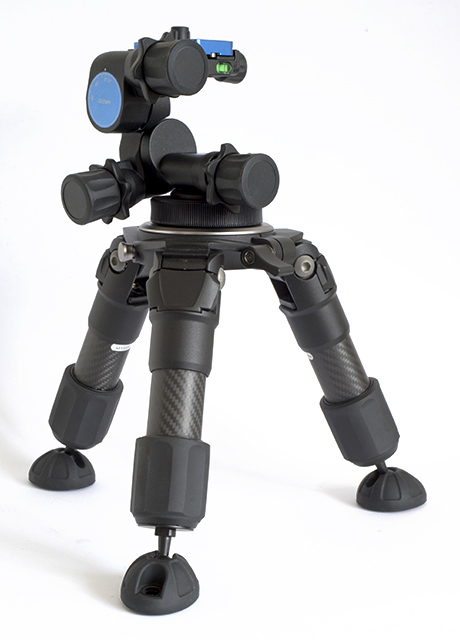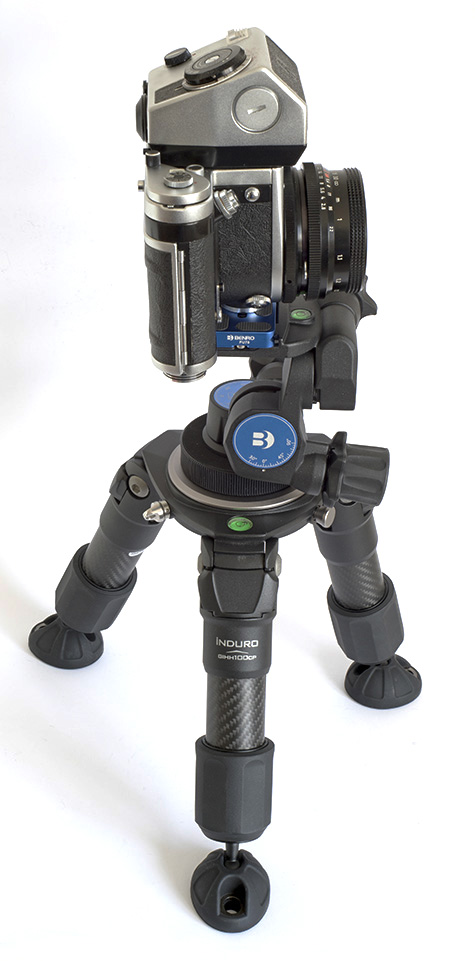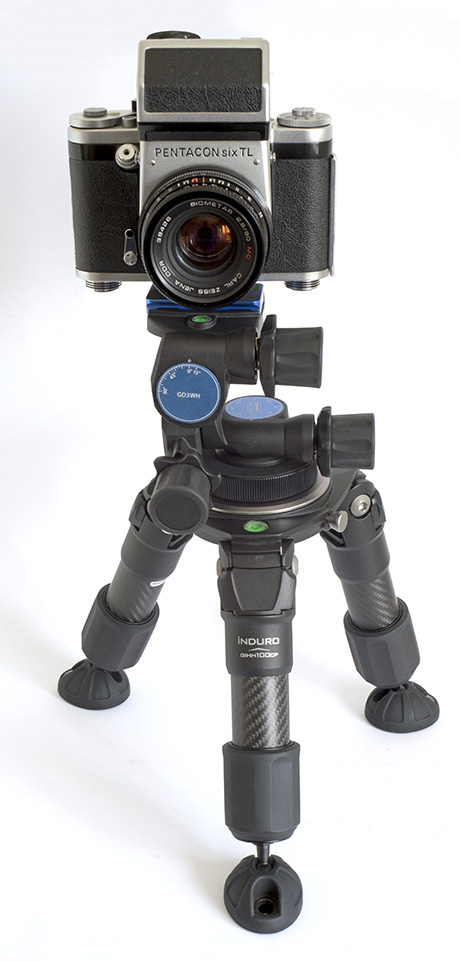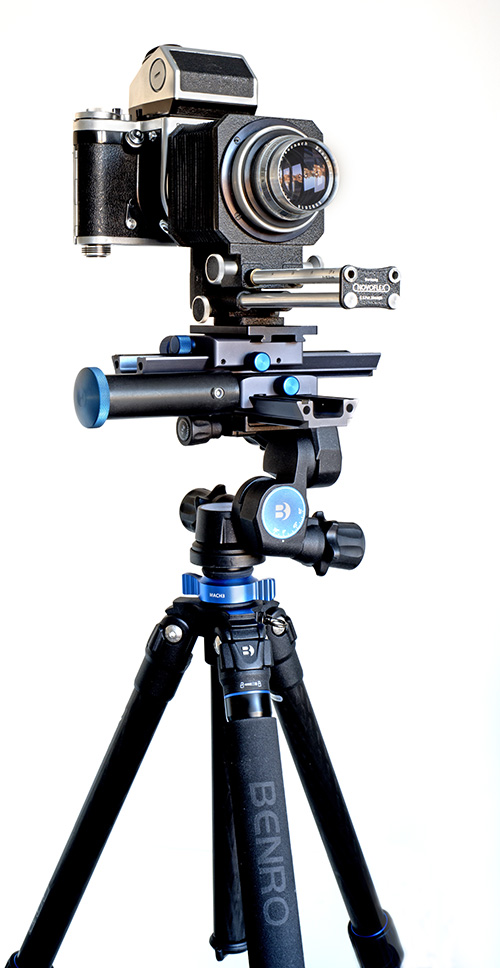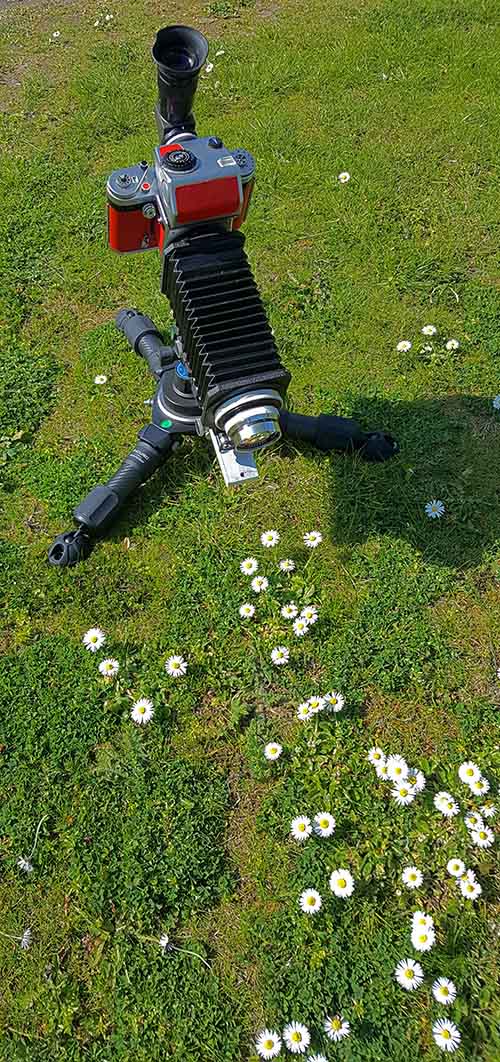by TRA
A tripod
for low-level shots
I do of course have the Berlebach UNI 14, which is reported on in detail here. It is superb for ultra-heavy and ultra-long lenses, such as the 1000mm Carl Zeiss Jena Spiegelobjektiv. However, it is not designed for working with the camera very near to ground level, and is rather bulky for taking on trips and routine use.
So now the search was on for a new tripod.
The Challenge
Ideally, the new tripod would be suitable for multiple purposes:
- with a range of the normal heights (approximately 1.5m to 1.8m)
- plus suitability for ultra-low shots (for instance, of flowers, not just looking down on them from above, but straight on from near ground level).
It should go without saying that a tripod should hold the camera outfit rock-steady, but this is particularly true when using ultra-long lenses or shooting macro shots, because in both of these cases:
- the depth of field is extremely shallow
- the only way of increasing this is by stopping down the lens, often to a very small aperture
- this will usually result in the need to use an extremely long (slow) shutter speed
- with these massive degrees of magnification, the effects of any movement by the camera outfit will also be magnified, resulting in unsharp images or even what appear to be multiple images.
|
1 kg
1 kg 3.4 kg 4.9 kg |
||||
| (all weighed with
a luggage scale – probably not as accurate
to the last gram as scientific scales, but
definitely accurate enough!) |
|||||
I have included here the Arca-Swiss B1-G ball head, as I already have this, so the total weight with that shows the load that a tripod must comfortably be able to bear without risk of movement.
The weight on the previous line shows the load that a tripod head needs to support. Many reviews indicate that ball head manufacturers often make exaggerated claims for the loads that their products will support. However, the real test is not what the ball head will hold still when the weight is carefully and evenly distributed when the centre of gravity is right above the ball head, but what it will hold totally immobile when the outfit is tilted at an extreme angle – for instance, up, to shoot birds in flight or down, to shoot plants, butterflies, etc., all of which inevitably shifts the centre of gravity.
What you get when you buy a tripod
As with the Berlebach, I discovered that the more “serious” tripods do not come with any sort of head, so I would need to find a suitable head, which might be a pan-and-tilt head or a ball head. (Or there is another possibility – see near the bottom of this page, here.) Again, I do still have the superb Arca-Swiss B1-G ball head, which is also reported on here, but I may appreciate having a smaller, lighter head for some situations or trips.
I looked at a friend’s tripod from a major European tripod brand, purchased a year or two ago, and discovered that carbon fibre tripods are a lot lighter than my 1970s aluminium tripod, but just as stable – or even more so. Some current ranges of tripods are available with a choice of carbon fibre or aluminium, with the carbon fibre ones being lighter and the aluminium ones being cheaper.
A tripod that goes really low down
One of the problems in getting near ground level with some tripods is that, no matter how far out the legs are splayed, the centre column eventually touches the ground and one can’t get any lower. Some tripods will take the camera upside-down at the base of the centre column, or by turning the column upside-down (see, for instance, here, near the bottom of the page). That may work fine in the studio, but is not very practical out “in the field”, especially if it is a real field, or a garden or park, or a shore with waves splashing nearby.
After significant research on the internet, in March 2019 I was able to go to the annual Photography Show at the National Exhibition Centre near Birmingham (U.K.). Here I was able to see vast numbers of tripods from brands both famous and unknown.
My on-line research had revealed that some, at least, of the Benro tripods (blue seems to be the company colour) were supplied with both a standard and a short centre column. This might be the solution.
At the Mac Group Europe stand I was able to see a wide range of Benro tripods. Internet research had suggested that a tripod from the light-weight Benro “Travel Angel” range might be suitable, but I had taken a Pentacon Six with me, along with Novoflex bellows and the 150mm Schneider-Kreuznach Xenar lens (see here), and it was clear that something sturdier was required. An extremely helpful Mac Group representative (Mark) recommended a tripod from the sturdier Benro Mach 3 range. As far as I could see, these were available in three sizes, the 28, 38 and 48, with the higher numbers indicating greater maximum height, and obviously an increase in weight and in the minimum folded size. The higher ranges towered above me – fine for a professional photographer with a small stepladder who wanted to set up behind a crowd, but not necessary for my requirements.
I tried my outfit on a Benro TMA28C and it seemed spot-on, so I bought one from a retailer at the show.
My internet research had also revealed a special low-level tripod, the Induro GIHH100CP, although I could only find them for sale in the U.S.A. It turns out that they are no longer distributed in the U.K., but I have been able to buy one and so report on it here.
|
This report
therefore covers:
|
The Benro Mach3 TMA28C Carbon Fibre tripod
The Benro Mach3 TMA28C comes well equipped with accessories.
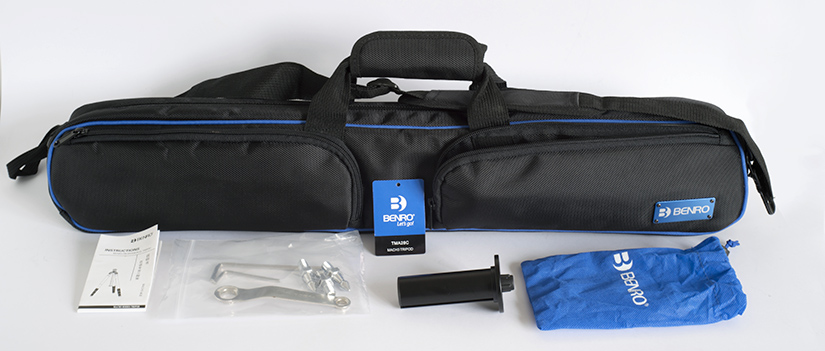 The Benro Mach3 TMA28 is supplied in a well-padded bag with two outer pockets. In this image we also see the instructions, the tool set and the short column, with its own cloth bag. These items fit well into the outer pockets. [TMA28_01.jpg] |
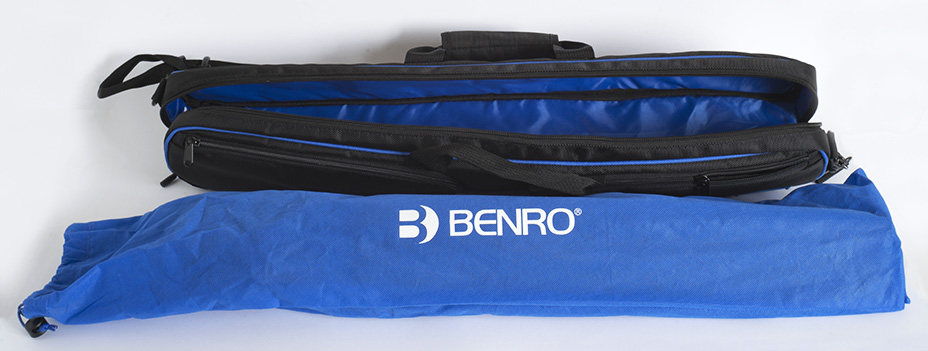 Inside the padded bag, we find that the tripod itself is inside its own cloth bag. We can thus put cable releases in the bag beside it, without any danger that they will scratch the tripod. [TMA28_02.jpg] |
|||
 Here the tripod can be seen with its long centre column in place. There is a hook on the bottom of the centre column, so that in windy conditions a bag or other heavy item can be hung underneath the tripod, to increase stability. [TMA28_03.jpg] |
 The tripod bag, and the inner cloth bag, are long enough to hold the tripod with a head in place. Here the Benro B3 ball head is shown on the tripod, and we have not included the cloth bag, to enable the contents to be seen. [TMA28_04.jpg] |
Not very obvious in the above pictures is the removable shoulder strap for the Benro tripod case. For the detailed specifications, see the table lower down on this page.
The Induro GIHH100CP Carbon Fibre tripod
Like the Benro Mach3 tripod, the Induro comes well equipped with accessories.
| The Induro is
supplied in a smart and compact padded bag and in
their publicity the manufacturers point out that
it can easily be part of cabin luggage on an
aeroplane. Here we see also the instructions, a card that lists the specifications, and four further items:
|
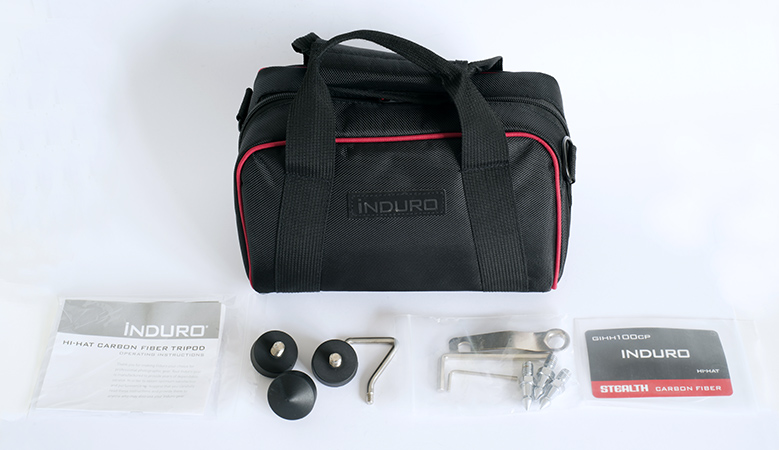 [GIHH100_01.jpg] |
Inside the padded
bag, we find that the tripod itself is inside its
own cloth bag. We can thus put cable releases or other small accessories in the bag beside it, without any danger that they will scratch the tripod. |
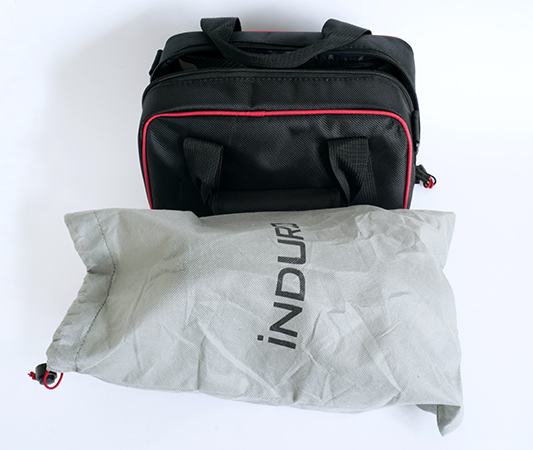 [GIHH100_02.jpg] |
||
| Here is the tripod,
complete with its highly-adjustable pod feet that
will swivel to any desired angle. The
manufacturers state that they will take a firm
hold on any surface and even suggest that they
enable the tripod to be used on a car bonnet
(American English “hood”?) without scratching it –
although I will not be testing this on my car! Its “short, fat legs” are definitely “perfectly formed” (a reference that will be understood by U.K. fans of Morecambe and Wise!). They can be extended to approximately double the length that is visible here. (This picture was shot with a wide-angle lens, which is why the tripod appears to be bigger than the bag, which is of course not the case.) |
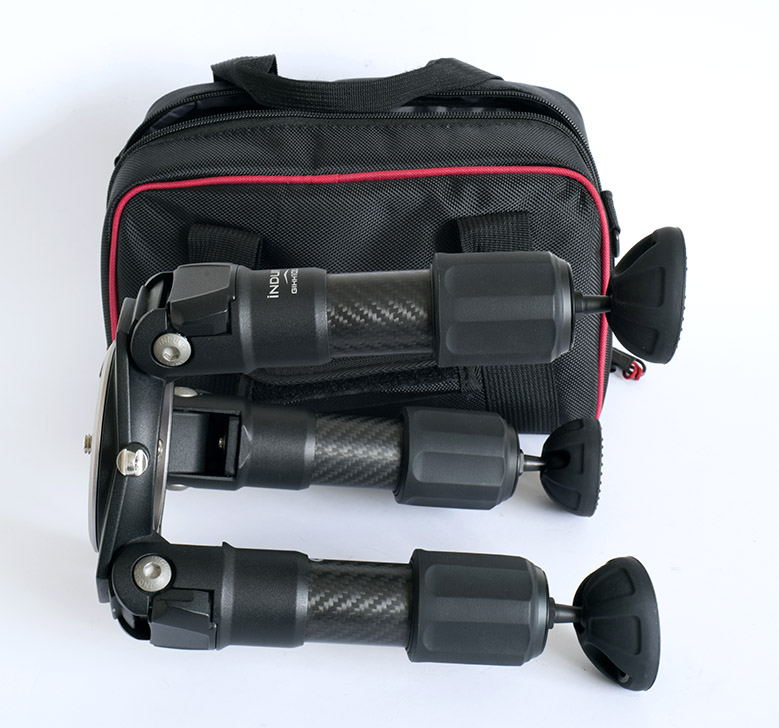 [GIHH100_03.jpg] |
This view from above
shows the built-in bubble level, the approximately
100mm diameter top plate, with its 3/8" mount for a suitable head, and an
alternative view of the pod feet, each of which
has a hole so that the tripod can be bolted to a
larger base if desired. The top plate can be rotated, or even removed and replaced with an alternative top. The manufacturers also offer a bowl-like plate with an equivalent bowl with a flat top that fits into it, enabling easy adjustment of angle. Videographers apparently call this top a “Hi Hat”. |
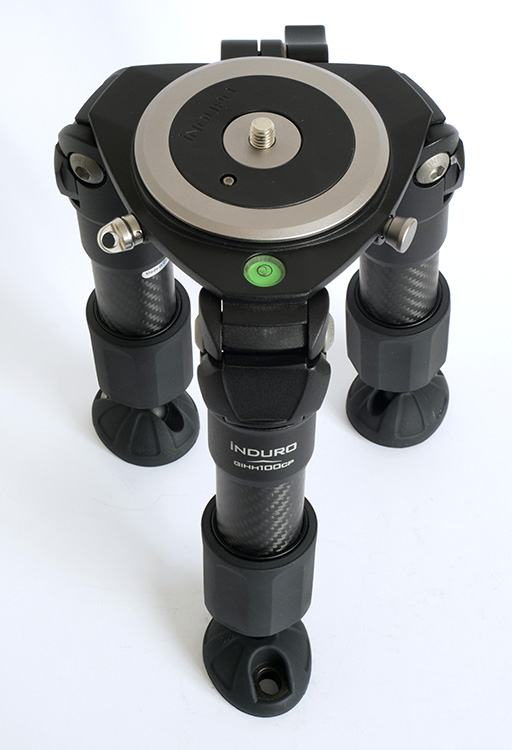 [GIHH100_04.jpg] |
The similarities of style and design detail for these two tripods are quite remarkable, and the USA distributor of both of these brands of tripods states that they are manufactured in the same factory. (See the YouTube video on servicing the leg assemblies for these tripods here – last accessed on 31.3.19.) We also note that the box in which the Induro outfit was supplied bore the Benro name, logo and slogan on four sides. For the user of these two tripods, this does make usage quite intuitive when switching from one tripod to the other: for instance, the legs open, extend and tighten in exactly the same way with both models. For the detailed specifications, see the table below.
Tripod Specifications
| Tripod
Specifications (as indicated by the manufacturers / items in italics by me) |
||||
| Tripod |
Benro TMA28C |
Induro GIHH100CP |
||
| Sections |
4 |
2 |
||
| Maximum Height (incl. centre column) |
155.4 cm / 61.2" |
(no centre column) |
||
| Maximum Height (without centre column) |
135 cm / 53.1" |
28.0 cm / 11" | ||
| Folded | 53 cm / 20.87" |
23.5 cm / 9.3" | ||
| Minimum Working
Height (to top of platform) |
31 cm /12.2" (by my measurement, just 14.7 cm with the short column down and the legs fully splayed) |
7.7 cm / 3.03" (with pod feet) |
||
| Weight |
1.54 kg / 3.4 lb |
1.7 kg / 3.8 lb |
||
| Maximum Load |
14 kg / 30.86 lb |
100 kg / 220.5 lb |
||
| Diameter of column platform |
On main column: 56mm |
100mm |
||
| Diameter of column
platform |
On short column: 49mm |
– |
||
| Bubble level |
Yes |
Yes |
||
| Head mount type |
3/8" with adapter to ¼" included | 3/8" | ||
| Feet |
Rubber feet & Spikes |
Pods, Rubber feet & Spikes |
||
Yes, that really is a minimum working height of just seven point seven centimetres (77mm) for the Induro, not a typing error by me. I have measured it several times, as I thought that it couldn’t be that low, and that I must have made a measuring or transcribing error. The different sorts of feet should not make a significant difference to the working height, so I have not measured with them in place.
The Benro B3 Ball head
| The Benro
B3 Ball head is supplied with an Allen (hexagonal)
key and a 3/8" to ¼"adapter bush, so that its 3/8" base can be mounted on a tripod with
a ¼" attachment bolt. We note that the bolt on the top plate is protected for transit with a rubber cap (as are both of the centre columns for the Benro tripod described here). In this picture we see bottom centre of the ball head the degrees window for use when panning and bottom left the pan locking control. To the right of the ball head we can see the friction control wheel. The cut-out at the front of the B3 allows the head to rotate down a full 90°, to be able to turn a camera quickly from horizontal to vertical format – not a feature that we require with the Pentacon Six or other 6 × 6 cameras, but clearly useful for many other cameras. |
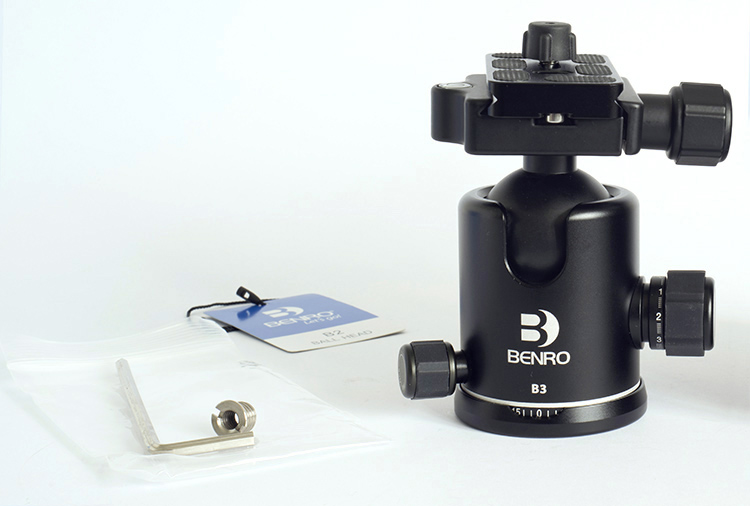 [B3_01.jpg] |
|
Rotating
the unit, we can see the large ball-locking knob. Above it, near the top, is the locking knob for the “Quick Release” plate. Benro supply their PU60 top plate with this ball head. The base for this plate is essentially Arca-Swiss compatible, although additional safety features make its operation slightly slower than with the original Arca-Swiss design. These features are designed to protect the camera by making it impossible for the mounting plate to slide out accidentally, and to prevent users from unintentionally loosening the plate locking screw too far. It would appear that many photographers look for such safety features when shopping for a ball head. |
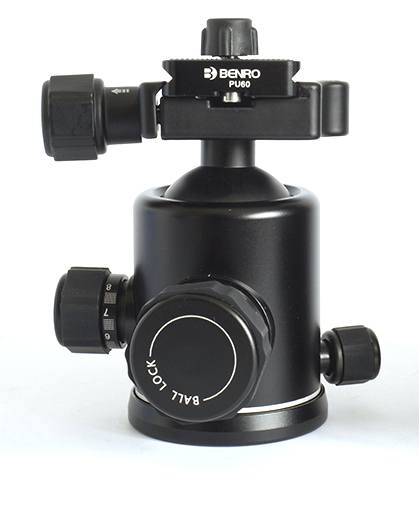 [B3_02.jpg] |
The Arca-Swiss B1-G Monoball head
| When I bought the
B1-G about ten years ago, it was supplied as seen
here (in a strong cardboard box, of course).
There were no accessories included and not even a
quick-release plate. At the base here we see the degrees window that can be used to determine the exact angle when panning, of required. This is no longer a current model, but Arca-Swiss do still offer a range of premium-quality ball heads and accessories. |
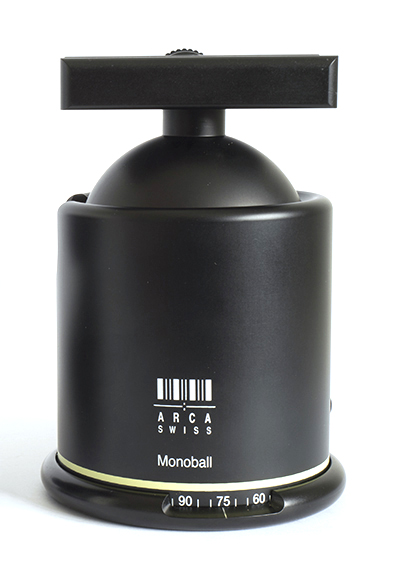 [B1G_01.jpg] |
From this angle we
can see all of the controls: at the top is the locking knob for the quick-release plate. On the base, in the far left in this picture, is the pan locking control knob. Just in front of it, from this angle, is the main ball lock knob and, recessed within it, the thumb knob for adjusting the friction. As one is likely to set the friction control only once for a given outfit, this system works well: there is no danger of accidentally loosening the friction when all one meant to do was to loosen the ball head lock. The friction control on any ball head is designed to prevent the head flopping over when the main lock is loosened, as it will hold the camera outfit steady, while loosening the main lock enables adjustment of the angle. Just visible to the right here is the cut-out in the base that allows the head to rotate down a full 90°, to turn a camera quickly from horizontal to vertical format (not required for the Pentacon Six, but undoubtedly a useful feature for many other cameras). |
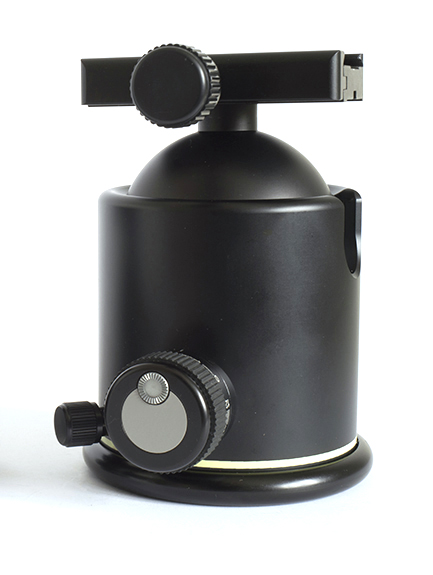 [B1G_02.jpg] |
For more pictures of the Arca-Swiss B1-G Monoball head and information on it, see here.
| In his on-line review
of the Arca-Swiss B1-G (here,
accessed on 30.3.19), Bryan Carnathan states: “For many years, the Arca-Swiss Monoball B1 Ball Head has been the standard by which all other ball heads are judged. Try one - you will quickly know why. “Although not inexpensive, the Arca-Swiss Monoball B1 Ball Head delivers on quality. With the exception of a non-captive universal clamp thumbscrew (why not Arca?) - fit, finish and functionality of the B1 are exceptional. “One of the Arca-Swiss Monoball B1 Ball Head’s differentiators is that it is an aspherical ball head. As the load on the head is moved away from center, the effects of gravity increase. To offset the higher gravitational effect, tighter tension control is needed. Conventional ballheads require correcting tension control adjustments to be made. The Arca-Swiss Monoball B1 Ball Head, by virtue of its elliptical nature, automatically adjusts to handle the off-center load. The tension automatically gets tighter as you move the load off-center. And it works as advertised. Very nice. “Tension adjustment on the Arca-Swiss Monoball B1 Ball Head is via a small thumb-dial on the main friction knob. I really like that it is easy to set but not easy to accidentally change ... “Another nice feature is the indexed friction control knob. This allows you to know how tight/loose your Arca-Swiss Monoball B1 Ball Head is without having to test it. The 360 degree panning base is also indexed (helpful for panoramic shots). A universal clamp on the Arca-Swiss Monoball B1 Ball Head accepts universal quick-release body plates and lens plates. ... “Is a 90 lb load rating high enough for you? If so, the Arca-Swiss Monoball B1 Ball Head will handle your equipment weight.” (Emphasis added) |
An Arca-Swiss brochure from 2005 states, “The B1g features the largest aspherical ball of the series B1 models. providing for the best camera work and positioning of even the heaviest cameras.”
Ball Head Specifications
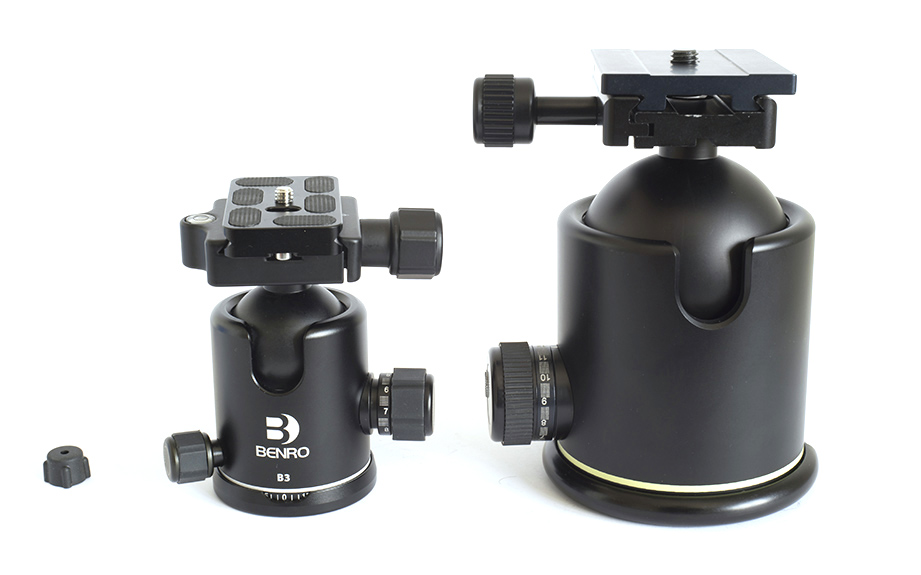 [B3_B1G_03.jpg]
|
||
| Here we
can see the relative sizes of the Benro B3 and
the Arca-Swiss B1-G. In this photograph we
have removed the rubber protective cap from the
top of the Benro PU60 plate and placed it on the
left, and for the Arca-Swiss B1-G we have added
a genuine Arca-Swiss “Quick-Release”
plate. By slightly slackening off the top
knob, this can be slid fully out, either
forwards or backwards – possibly an advantage,
but possibly also a risk, if we are not firmly
holding the camera and lens that are mounted on
the ball head. By contrast, when we look at the Benro PU60 “Quick-Release” plate, we can see on its underside a chrome protrusion or “button”. There is also one at the other end. This prevents the “QR” plate from sliding out. What is more, the QR plate locking knob has two positions: loosening it as far as it will go enables us to slide the plate backwards and forwards, to fine-tune focus or composition, for instance. To remove the plate completely, we must now pull on the locking knob, which will then allow us to turn it further and so create enough space to lift up the QR plate and remove it – a slower procedure, but no doubt a safer one. However, these studs do make this Benro plate unusable on top of the Novoflex Castel-Cross Q, described below, as it is not long enough for the studs to overlap both ends of the Novoflex Quick Release base. For the same reason, it will not be possible to use this Benro plate on top of the Quick Release base of the Arca-Swiss B1-G that is described here. |
| Ball
Head Specifications (as indicated by the manufacturers / items in italics by me) |
||||
| Ball Head |
Benro B3 | Arca-Swiss B1-G | ||
| Height |
10.4 cm / 4.09" |
With the ¼"
universal camera plate: 14.6 cm / 5¾" |
||
| Maximum Load |
18 kg / 39.68 lb |
Reportedly 90 lb (see review below) |
||
| Weight |
0.46 kg / 1.01 lb |
With the ¼" universal camera
plate: 1560 g / 3 lb 8½ oz |
||
| Tilt Range |
-45° / 90° |
-45° / 90° | ||
| Diameter of base |
58mm |
100 mm |
||
| Panning Lock |
Yes |
Yes |
||
| Friction control |
Separate knob |
Integrated within main knob |
||
| Bubble Level |
Yes |
No |
||
| Base mounting thread |
3/8" | 3/8" | ||
| Top plate |
PU60 Quick-Release plate (partially Arca-Swiss compatible) |
Genuine Arca-Swiss Quick-Release
mount Plates need to be bought separately. |
||
Maximum heights achieved
For non-low-down shots, the maximum height should be noted.
The Benro Mach3 TMA28C
When using the Benro Mach3 TMA28C with the Pentacon Six on the Benro B3 ball head, with the Novoflex Cross-Castell Q and the Novoflex bellows with their integrated focussing slide, the pentaprism eyepiece is way above eye height for me. (I am of reasonably common adult male height). However, if I extend one less leg section I can achieve perfect height, and further adjustment is possible by using the long centre column or slightly extending the legs further.
For a comparison of this tripod with the Berlebach UNI 14, see here (scroll down).
The Induro GIHH100C
The manufacturer’s specification states that the maximum height of the platform of the Induro is just 28.0 cm / 11", and one is likely to be on the lookout for exceptionally wide walls, steps, a convenient table, etc. for use at a normal, standing height. However, this is not the real purpose of this tripod, so it cannot be viewed as a limitation. What we are more interested in for this context is the minimum height.
Minimum heights achieved
Both tripods have been photographed with each of the two heads, keeping the camera used for these pictures in exactly the same position for all of these four shots. I have not cropped out the surplus white space round the Induro, to make the relative sizes of the two tripods at their minimum height settings easy to see. Each ball head is fitted with a standard plate from the ball head manufacturer, the PU60 plate for the Benro and the 3/8" plate for the Arca-Swiss Monoball.
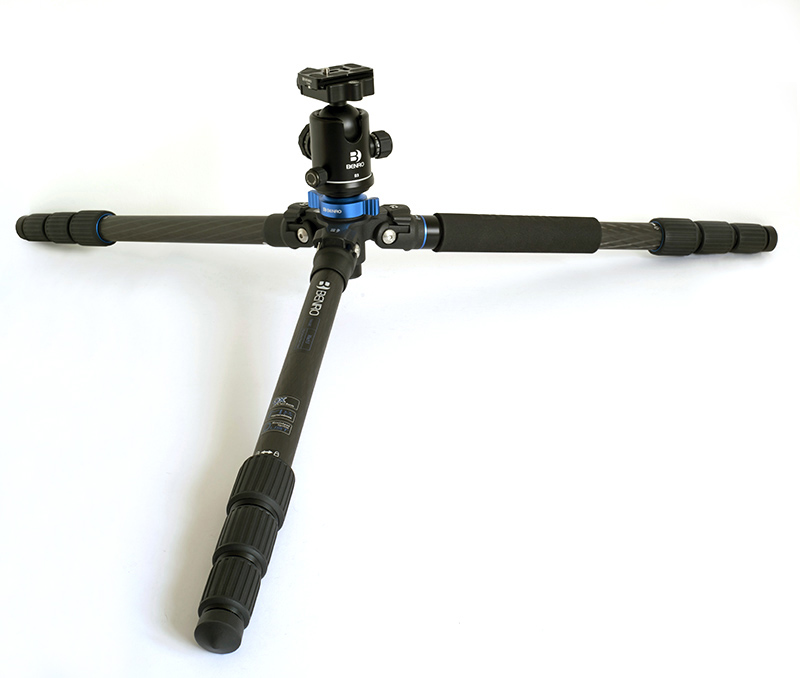 Benro Mach 3 TMA28C tripod with Benro B3 ball head Total height: 251mm [TMA28_B3.jpg] |
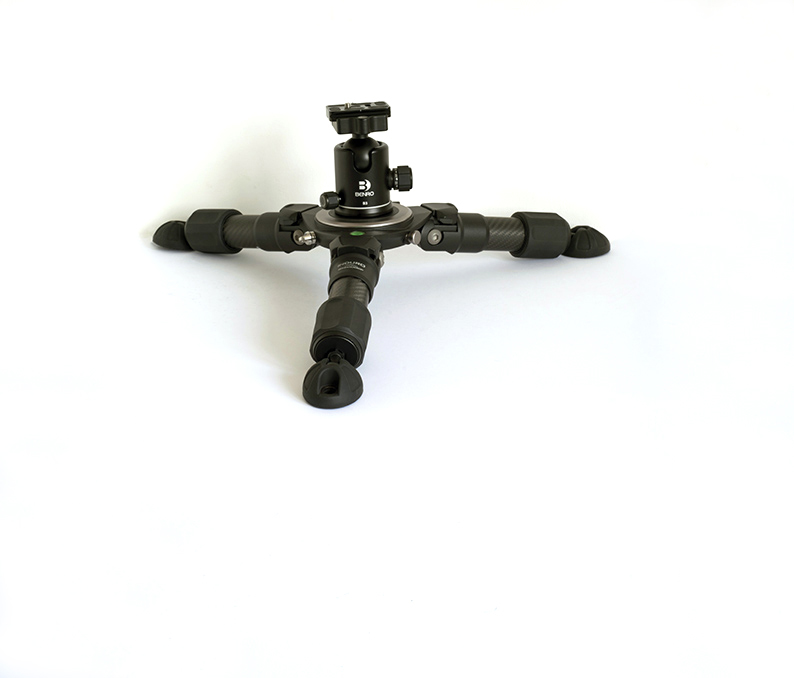 Induro GIHH100CP tripod with pod feet, with Benro B3 ball head Total height: 184mm [Induro_B3.jpg] |
|
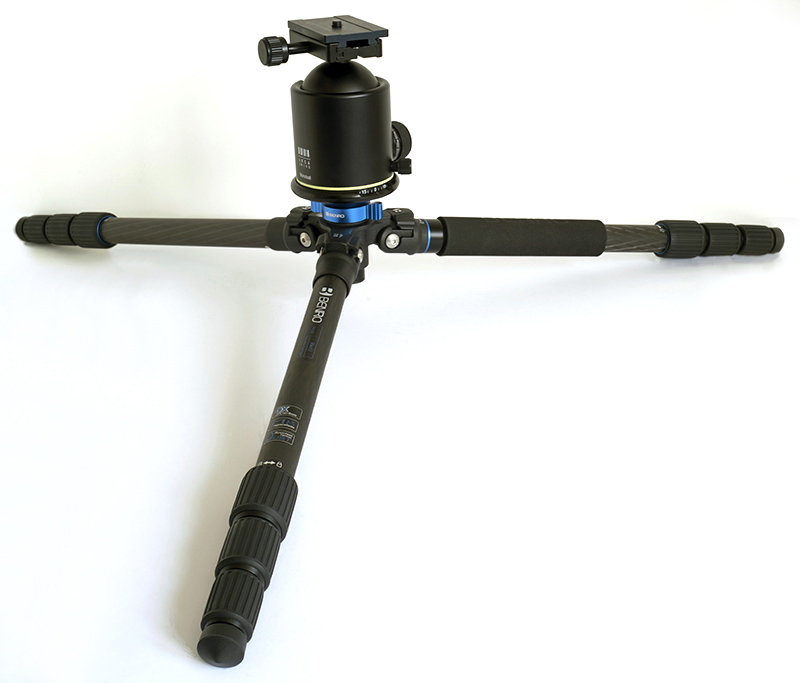 Benro Mach 3 TMA28C tripod with Arca-Swiss B1-G Monoball head Total height: 292mm [TMA28_B1-G.jpg] |
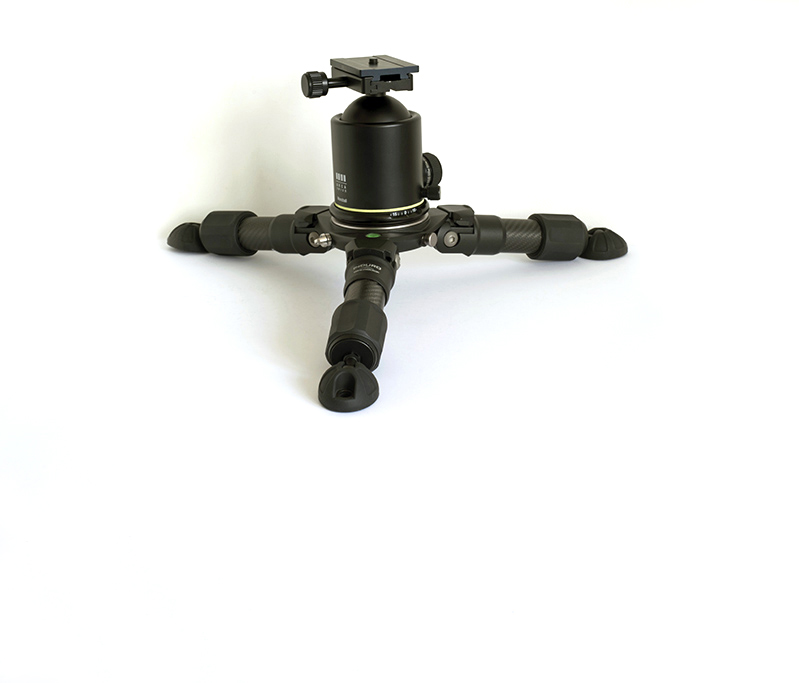 Induro GIHH100CP tripod with pod feet, with Arca-Swiss B1-G Monoball head Total height: 224mm [Induro_B1_G.jpg] |
Either ball head can be safely used with either tripod. However, it is clear that B3 with its base diameter of approximately 58mm goes better than the large Arca-Swiss Monoball on the short centre column of the Benro tripod, with its platform diameter of 49mm. The B3 also goes well on the Benro long centre column, which has a platform diameter of 56mm.
Likewise, the Arca-Swiss B1-G, with its 100mm base diameter, goes better than the Benro B3 ball head on the Induro, with its platform diameter of 100mm. The Arca-Swiss B1-G with its standard 3/8" plate is about 40mm taller than the Benro B3 with its standard PU60 plate. However, in spite of the greater height of the Monoball, the combined height with the Induro GIHH100CP is still significantly lower than the Benro TMA28C with the much smaller Benro B3 head. It is clear that when minimum height is required, the Induro is the tripod to use, even with the large Arca-Swiss monoball, and if we need to get a further 40mm nearer to the ground, then the Benro B3 ball head can be used on the Induro tripod.
|
For comparison
purposes, here is the Pentacon tripod at its
minimum height.
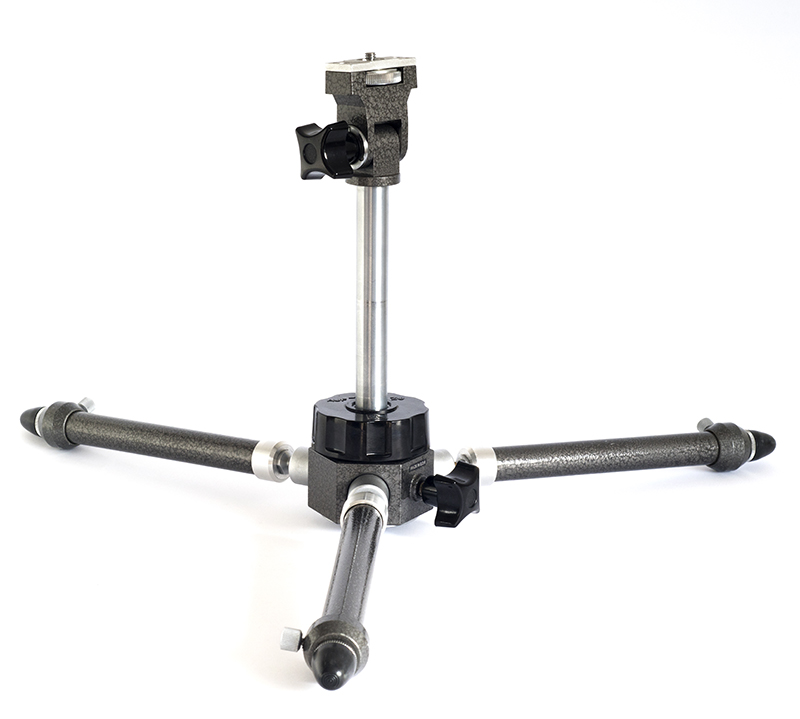 [ptpd_min_ht_s.jpg] The minimum height with the Pentacon tripod is 257mm. This is already very good, although it is possible to get the camera much nearer to the ground by attaching the head to the bottom of the centre column. The inconvenience with this setup is that when the camera is upright (i.e., not pointing down as when photographing an item from directly above), it will generally be operating upside-down. Note that this photograph was not taken at the same time as the ones above it, so the scale may not be the same. For more on the Pentacon tripod, see here. Click on
the above image to see it larger.
|
Next I show these two tripods with the Novoflex Castel-Cross-Q focussing and composition slides. I am here showing the Benro tripod only with the Benro B3 ball head, not the Arca-Swiss B1-G Monoball. I show the Induro tripod with both ball heads. Again, all three images were taken from exactly the same position and I reproduce all of them at exactly the same size for the items shown, although with the Induro pictures I have this time cut out some of the surplus white area. Height measurements were taken with the Arca-Swiss 3/8" plate on top of the Castel-Cross-Q (even although it was not in place at the time that the photograph of the Benro tripod was taken). Every endeavour was made to keep the top plate horizontal, and measurements are accurate to within approximately + 1mm.
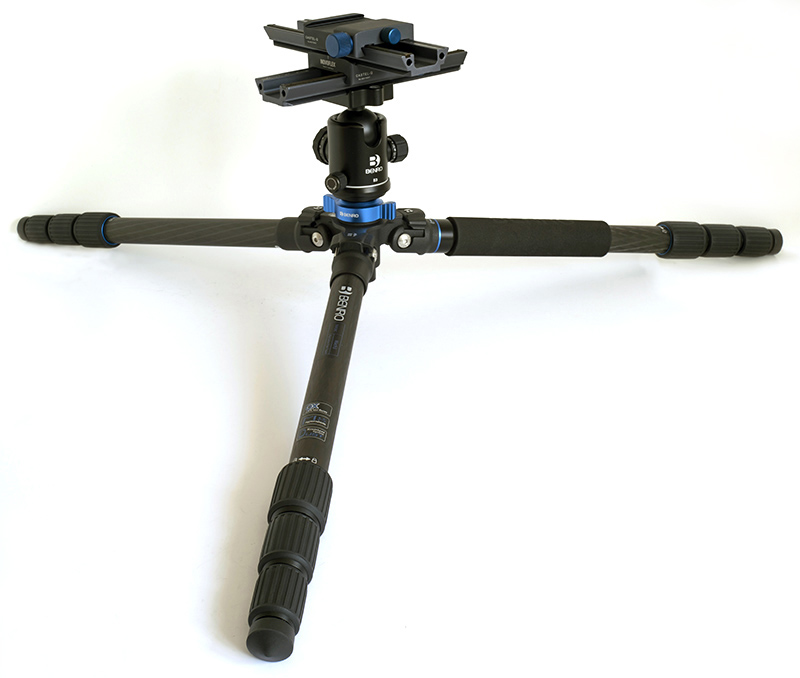 Benro Mach 3 TMA28C tripod with Benro B3 ball head and Novoflex Castel-Cross Q Total height: 306mm [TMA28_B3_Castel_Q.jpg] |
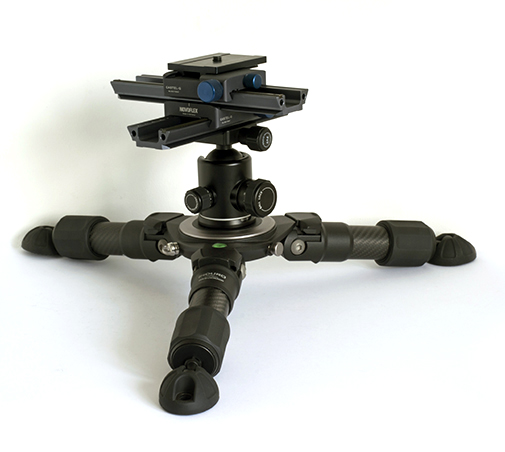 Induro GIHH100CP tripod with pod feet, with Benro B3 ball head and Novoflex Castel-Cross Q Total height: 239mm [Induro_B3_Castel_Q.jpg] |
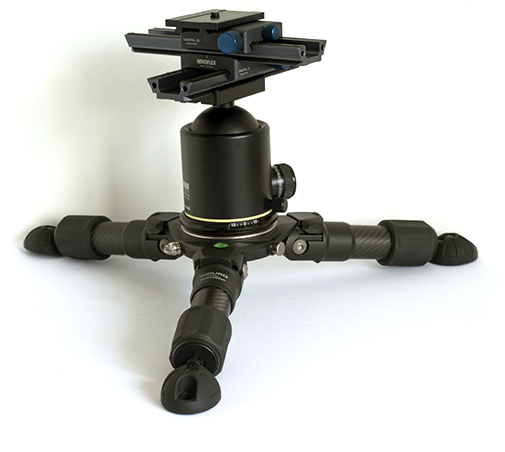 Induro GIHH100CP tripod with pod feet, with Arca-Swiss B1-G Monoball head and Novoflex Castel-Cross Q Total height: 277mm [Induro_B1-G_Castel_Q.jpg] |
Finally, here is what we set out to achieve:
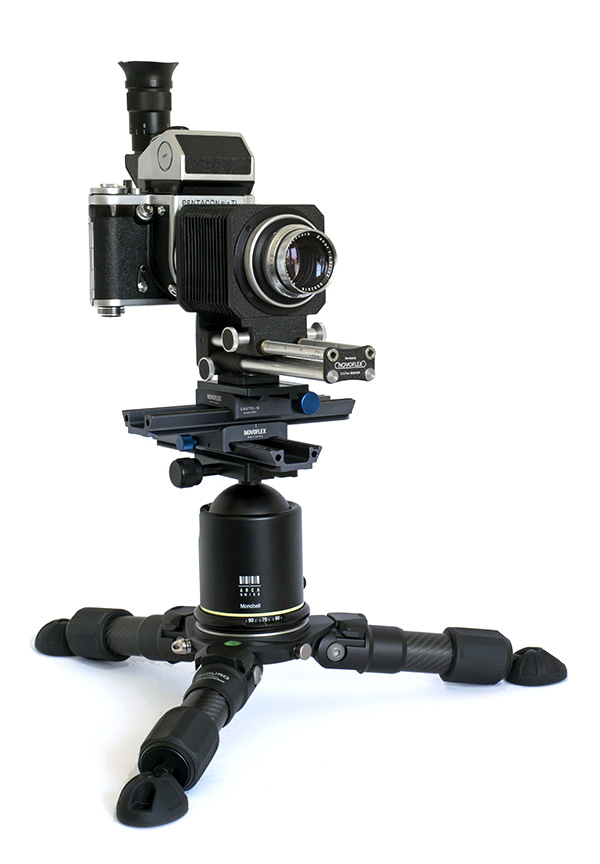 [Induro_B1-G_Castel_Q_180Xen_03.jpg] |
|
Here we see the
Pentacon Six with metering prism and angle finder
to facilitate viewing the image (and metering!)
when the camera is so near to the ground. On
it is mounted the Novoflex TISBIG bellows with the
Schneider-Kreuznach 180mm f/4.5 Xenar, via the
TISXURRING adapter. They are mounted via an
Arca-Swiss 3/8" Quick-Release plate onto the Novoflex
Castel-Cross-Q focussing and composition slides,
which are in turn mounted directly onto an
Arca-Swiss B1-G Monoball head, which is attached
to the Induro GIHH100CP tripod. Now we await a dry and sunny day, to try this out taking some low-level flower photographs. |
| A Geared Head |
|||||||||||||||||||||
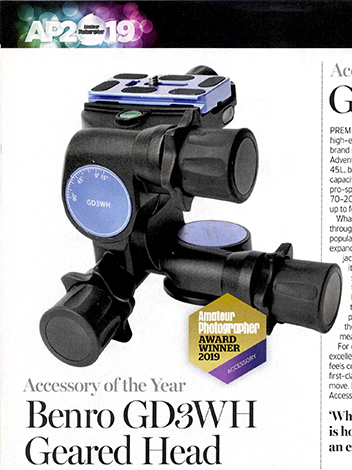 [AP_GD3WHc.jpg] From “Amateur Photographer” 13th February 2019, p44 |
An alternative to a
pan-and-tilt head (which is popular for filming or
video) or a ball head is a Geared Head. Geared heads have
a control knob for each axis: horizontal
rotation (panning), up-down angle (tilt),
left-right angle (to get the camera
horizontal – or even vertical!)
The “Accessory of the Year” in 2019 for the
popular U.K. photographic magazine “Amateur
Photographer” is the Benro Gear Drive 3-Way Head,
known for short as the “GD3WH”, so after
considerable on-line research I bought one from
the U.K. retailer Wilkinson
Cameras. They offered a competitive
price and superbly-speedy dispatch, passing it to
the carrier within minutes of my placing my
order. Here I report on my initial
experiences using this head with the Pentacon Six. As we are considering on this page how best to obtain low level shots, the first thing that we need to look at with this head is its height. To our surprise, even though it is clearly a lot bigger than the Benro B3 ball head, it is in fact, according to the specification, only 5mm taller than it. Here are other key specification details, taken from the box for each of the Benro heads:
|
||||||||||||||||||||
